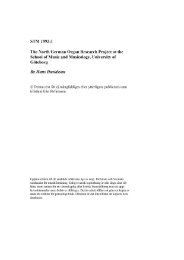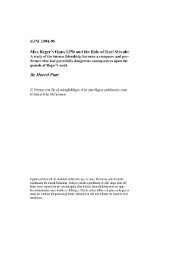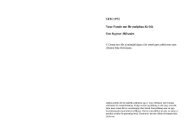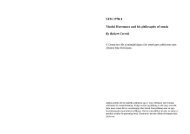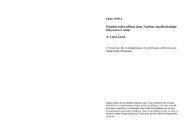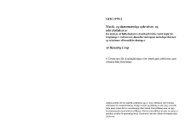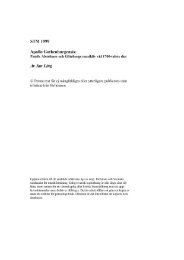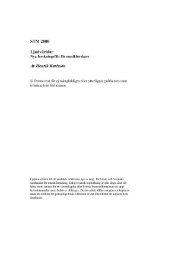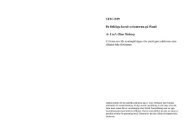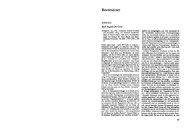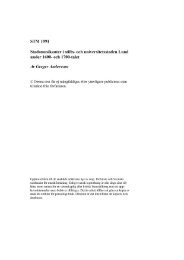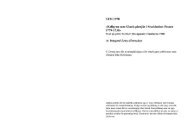You also want an ePaper? Increase the reach of your titles
YUMPU automatically turns print PDFs into web optimized ePapers that Google loves.
ing phonogram confirms what was already evident in the score, namely that one of<br />
the previously deleted sections of the Fugue was actually intended as a composed<br />
accelerando (with a simultaneous crescendo), which leads gradually from one speed<br />
to another. This occurs without any change of metronome values, as was the case in<br />
the previously discussed fugues in op. 46 and 59. Instead, Reger changes the<br />
timeflow from quarternotes and eightnotes into eightnote triplets, followed by<br />
groups of four sixteenthnotes in the first fugue, thus proceeding step by step into the<br />
12/8-rhythm in the second fugue (which begins ppp and develops to ffff), with its<br />
characteristic pattern of eight- and sixteenthnotes, similar to the fugue theme in<br />
Reger’s Mozart Variations op. 132, which was written in 1914. This “composed<br />
accelerando” does not of course appear in the usual abridged version, where the first<br />
fugue presents only the first expositions in quarter and eightnotes, and from there<br />
goes directly into the second fugue, which therefore appears as a real contrast<br />
instead of an originally planned logical release of an increased rhythmic tension.<br />
Likewise, some thematical answers in the second fugue were difficult to explain<br />
logically until another missing section (a few bars) had been discovered.<br />
Without any question, the complete version has a more convincing architectonic<br />
form than the abridged one. Rather than to respect Reger’s “last will”-i.e. by<br />
accepting the corrupted version— one should consider Elsa Reger’s (the composer’s<br />
wife) concerned remark in two letters to her friends Fritz and Gretel Stein about<br />
Straube’s negative attitude to Reger’s Requiem (without opus number; unfinished).58<br />
In her introductory summaries of the collaboration between Reger and<br />
Straube, the Reger scholar Susanne Popp has pointed out the gradually increasing<br />
critical attitude from Straube’s side. 59<br />
What reason do we have to believe that the abridged version of op. 135 b is the<br />
result of Straube’s influence, and not directly of Reger’s own consideration? Appar-<br />
ently, all changes are made in Reger’s own handwriting; the crucial omission of 30<br />
bars between the two fugues (i.e. the section where the written accelerando occurs)<br />
is, so to speak, authorized by Reger’s own handwriting in the new bar, which serves<br />
as a new pivot between the fugues. A facsimile reproduction in Popp/Str, p. 259,<br />
shows exactly how the operation was made, and how the already printed proofs had<br />
been cut and glued together after the elimination of the 30 bars in question. So far,<br />
nothing points directly towards Straube’s participation, which has instead to be<br />
considered from more circumstantial evidence.<br />
We know, from the published correspondance, that Reger had brought the proofs<br />
of a printed version of op. 135 b to a meeting with Straube on ii April 1916; on the<br />
following day he sent a message (from his home in Jena) that “all changes had been<br />
58 16 December 1914: “Straube hat ihm bewiesen, dass er dem Stoff nicht gewachsen ist u. nun kann er es<br />
nicht fertig schreiben . . . Wie oft— 5-6 Male weiss ich allein, hat Straube Werke von Max verworfen, die<br />
dann gross und herrlich waren u. ihren Weg gingen. Straubes Einfluss ist nicht gut auf Max.” 19<br />
December 1914: “Lieber Fritz, Max ist so unsagbar leicht zu beeinflussen u. steht z.Z. wieder ganz unter<br />
St. Bann . . . das vergisst Max aber stets wieder u. hört in erster Linie auf St.”. Cf. Popp/Str., p. 245-246.<br />
59<br />
Popp/Str., p. 9 et seq; 19 et seq; 128 et seq; 213 et seq.<br />
made’’, as a result of their discussion.60 To what extent Reger had made more<br />
changes than only the cuts at that time is difficult to say; at least some of the minor<br />
revisions are actually similar to those which Straube used to make in “his” edited<br />
versions. They may look like unimportant nuances, but nevertheless reflect<br />
Straube’s opinion in a rather typical way. The original tempo in the Phantasy<br />
becomes Quasi vivace instead of the original Vivace. Where Reger originally wrote<br />
meno vivace, with eightnote 96 (at the point where the two fugue themes occur<br />
together for the last time), the first printed version has instead Moderato molto, with<br />
eightnote 66; together with other details, such a slower tempo (and the impact of<br />
hesitation by using the word quasi) is typical for Straube’s broad and broadening<br />
tempi. We may remember here that he preferred to make cuts in Reger’s op. 127 (see<br />
above), so that the work would not be too long for the audience because of his slow<br />
tempo, by which the duration was extended by ten minutes!<br />
From a general performance point of view, the whole issue of cuts in a composed<br />
work is not unique in this special context. Both in operas, symphonies or chamber<br />
music, as well as in Handel oratories or Bach Passions, such cuts were often made<br />
by conductors and musicians (even if this habit does not seem to be so strong any<br />
more). One of Reger’s students, the well-known conductor Fritz Busch, discussed<br />
with Gustav Mahler’s widow the cuts which he had made in Mahler’s second<br />
symphony to make the work more stringent and less “talkative’’.61 Of course, the<br />
composer was dead and could not voice his opinion, but on the other hand, Mahler<br />
was known for his own revisions of the classic symphony repertoire.<br />
The difference between such “performers’ cuts” and those which were manipulated<br />
into Reger’s works before they were published, is that the musician who reads<br />
the new revised version, which is regarded as definitive, has nothing to choose<br />
between when making up his mind. Especially in op. 135b, Straube seems to have<br />
played the role of a censor-and even more questionable are other cases to which<br />
Elsa Reger refers (see above p. 55 footnote 44), like the unfinished Latin Requiem.<br />
Yet another interesting fact emerges from the documents in Popp/Str., namely the<br />
total absence of any comment from the composer’s side about Straube’s alternative<br />
editions— of which at least one was published during Reger’s lifetime— or alternative<br />
performance practices in general. On the front page of the three pieces from op. 59<br />
(Kyrie-Gloria-Benedictus) one reads that they are edited by Straube in agreement<br />
with the composer. But nowhere does Reger acknowledge that edition and neither<br />
does he make any other comment. His only letter with such a content is dated 4 May<br />
1904, where he says how happy and proud he feels that Straube had dedicated the<br />
first Alte Meister-volume to him. But, of course, we do not know what was<br />
discussed verbally between Reger and Straube.<br />
One important side of this issue must not be forgotten. When Reger— or any<br />
composer-sold a work to a publisher, this publisher got full control over the piece.<br />
This means that Reger had practically no legal right to object, if he ever had such an<br />
60<br />
Popp/Str. p. 258; cf. also p. 250 (message dated 30 April 1915).<br />
61 Grete Busch: Fritz Busch, Dirigent. Frankfurt a. M., 1970, p. 274.



